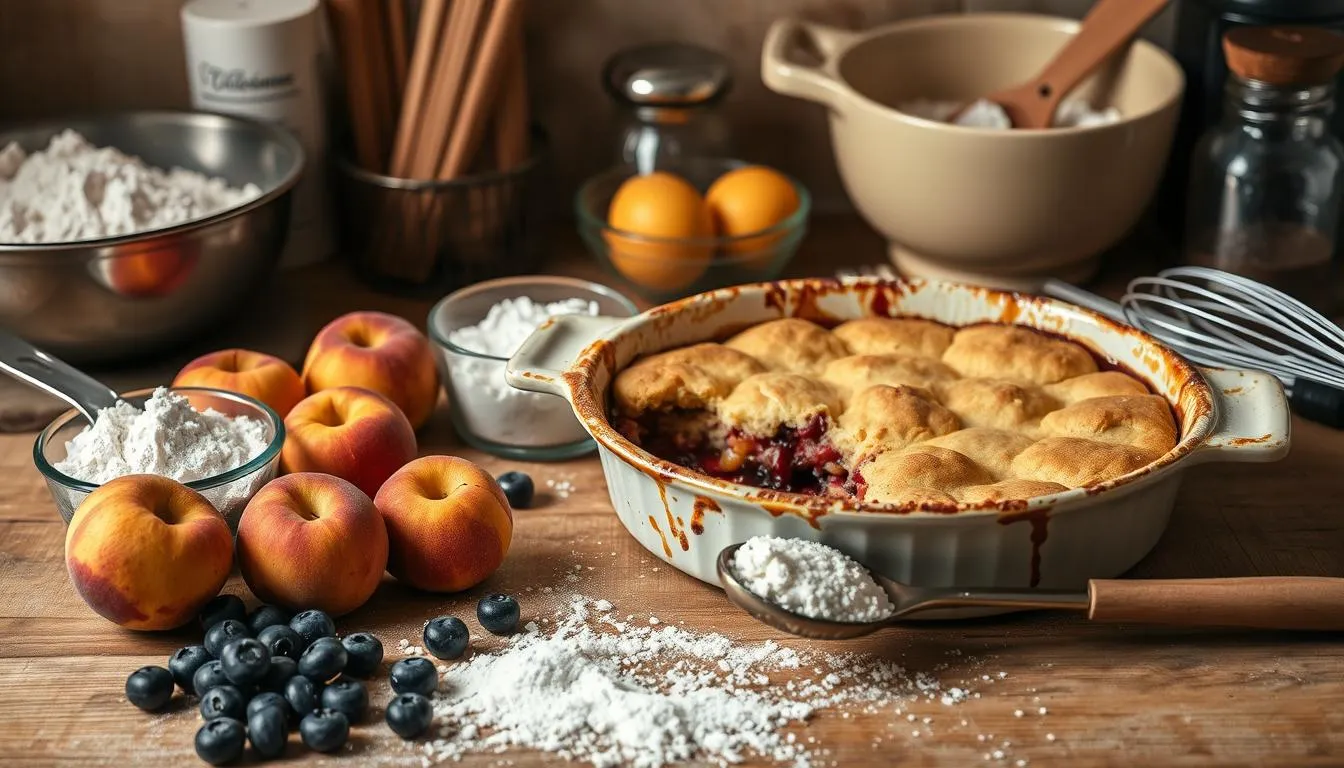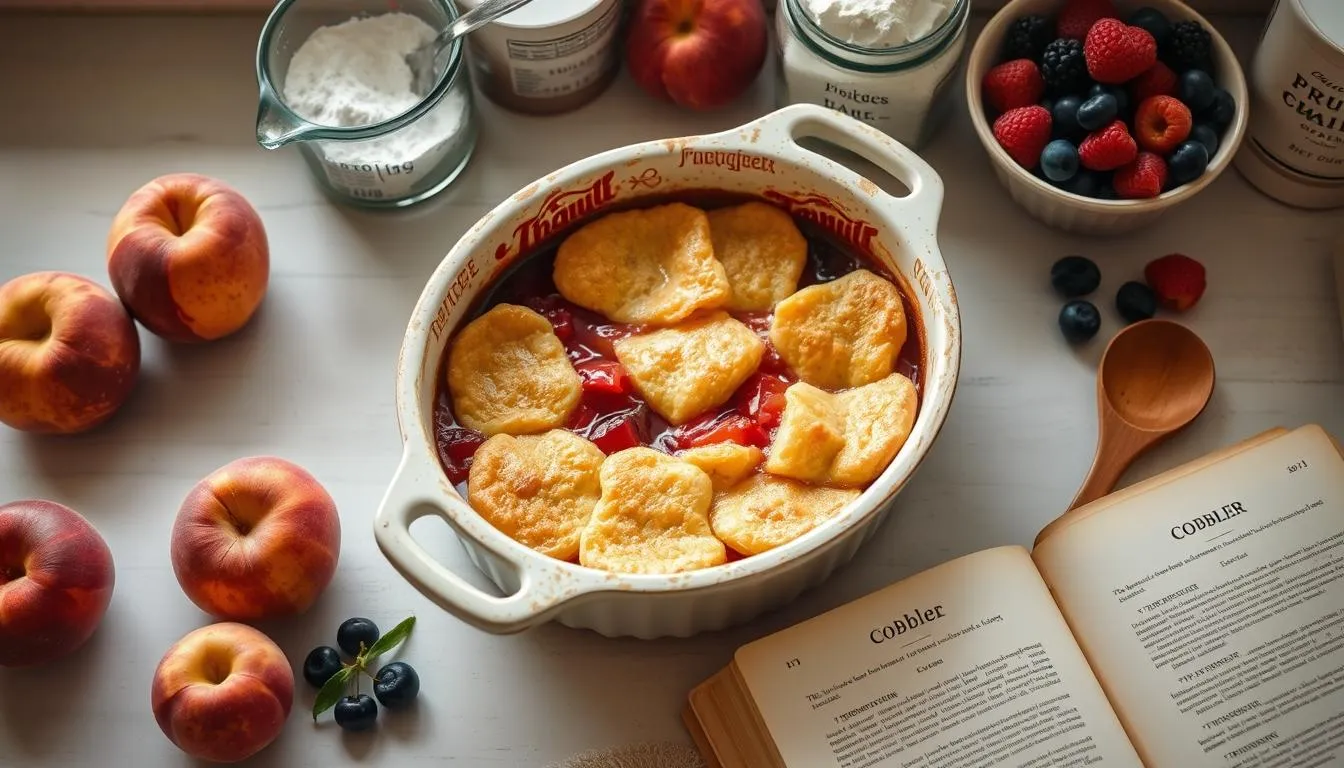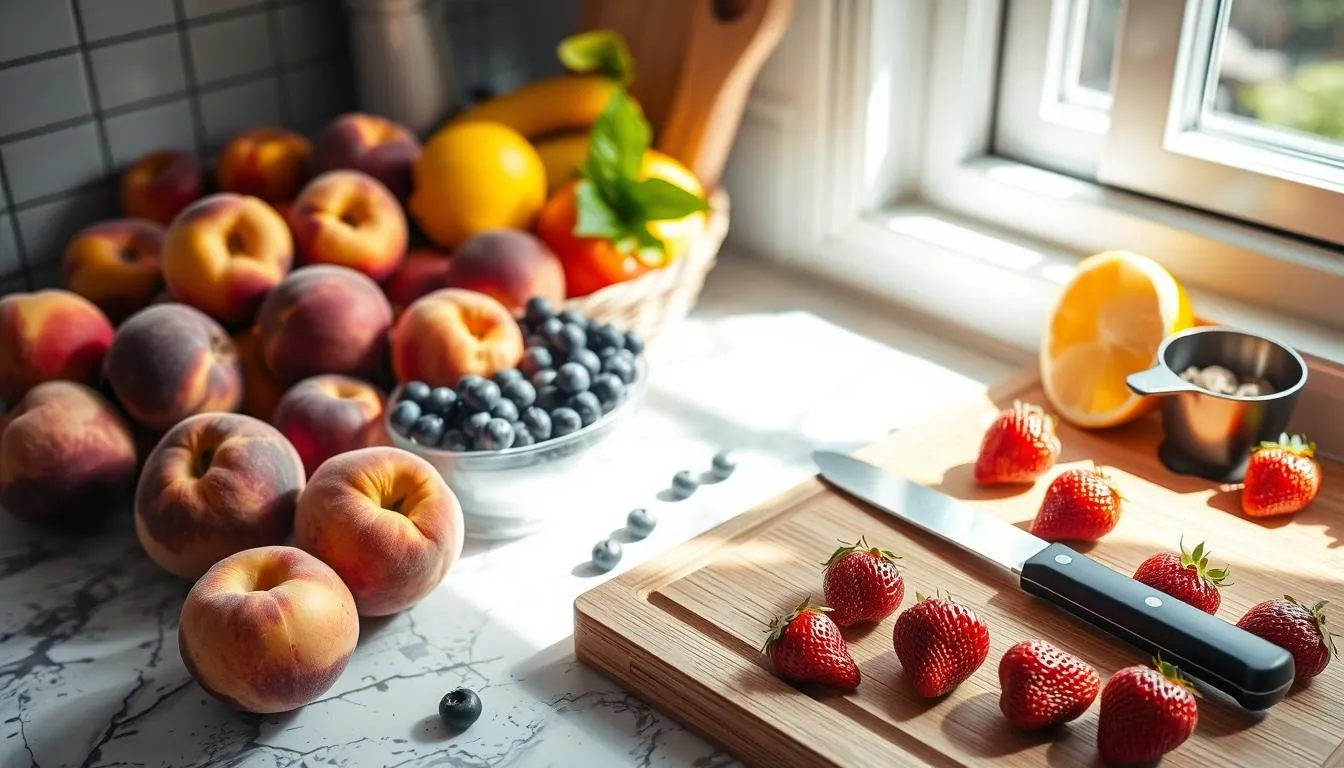Why is my cobbler so runny? Every baker knows the frustration of pulling a fruit cobbler out of the oven only to find it swimming in liquid. A runny dessert can turn a tasty treat into a mess. It’s important to understand the science behind dessert consistency to make a perfect fruit cobbler.
Achieving the right dessert consistency is all about precision and knowledge. Professional bakers know that texture is as important as taste in a cobbler. Whether you’re using peaches, berries, or apples, mastering baking techniques is key to avoiding excess liquid.
In this guide, we’ll look at why cobblers can be runny and share expert baking tips. You’ll learn how to make a dessert that looks good and tastes great. We’ll cover everything from fruit preparation to the science behind baking, helping you turn your runny desserts into hits.
Key Takeaways
- Understand the critical factors affecting fruit cobbler consistency
- Learn professional techniques to prevent watery desserts
- Discover how fruit selection impacts dessert texture
- Explore scientific principles behind perfect cobbler preparation
- Master temperature and ingredient management strategies
Understanding the Perfect Cobbler Consistency
Making the perfect cobbler is an art that combines fruit desserts and baking. The right texture turns a simple dessert into a memorable experience. It’s all about finding the right balance between fruit, topping, and baking.
What Makes a Cobbler’s Texture Ideal
A perfect cobbler has certain qualities that make it stand out. The key elements include:
- Balanced fruit filling with minimal liquid
- Tender, slightly crisp topping
- Harmonious blend of fruit and pastry
- Thick, rich filling that holds its shape
The Difference Between Runny and Properly Set Cobblers
Telling a well-made cobbler from a runny one is important. A good cobbler has a thickened fruit filling but not solid.
“The magic of a great cobbler lies in its ability to be juicy without being watery” – Professional Pastry Chef
Signs of a Well-Made Cobbler
Spotting a perfectly made cobbler involves looking at its appearance and feel. Here are the signs of baking perfection:
- Fruit filling that clings to the spoon
- Topping with golden-brown edges
- Slight resistance when cutting through the dessert
- Balanced moisture that doesn’t pool on the plate
Getting the cobbler texture right takes practice, patience, and knowing how ingredients work together during baking.
Why is my cobbler so runny?
Bakers often face the problem of a runny cobbler. This can turn a tasty dessert into a mess. Knowing why helps avoid common mistakes that make fillings watery.
Several things can make a cobbler runny. Fresh fruits have a lot of water, which can be too much for your recipe. This moisture can make the cobbler too wet and not set right.
- Inadequate thickening agents
- Incorrect fruit preparation
- Improper sugar measurement
- Overripe or water-heavy fruits
The type of fruit you use is key to a good cobbler. Strawberries, peaches, and cherries tend to make more juice. Using slightly underripe fruits or draining extra juice can help.
“A perfect cobbler is a delicate balance between fruit juice and thickening techniques.” – Professional Pastry Chef
Mistakes often come from not knowing how ingredients work together. Cornstarch, tapioca, and flour are important for soaking up extra moisture and making the filling stable.
| Fruit Type | Water Content | Thickening Recommendation |
|---|---|---|
| Peaches | High | 2 tbsp cornstarch |
| Berries | Medium | 1-2 tbsp flour |
| Cherries | Very High | 3 tbsp tapioca |
By learning about fruit dessert troubleshooting, you can fix a runny cobbler. It will become a perfectly set, delicious treat that everyone will love.
Common Ingredients That Can Make Your Cobbler Watery
Making the perfect cobbler means knowing how ingredients work together when baked. It’s all about managing moisture to avoid a soggy dessert. This is a problem for both home bakers and dessert lovers.
The Complex Role of Fruit Juices in Baking
Fruit juice can greatly change how your cobbler turns out. Fresh fruits let out water while cooking, which can make your dessert too wet. The amount of water in fruits varies, affecting the dessert’s texture.
- Berries usually let out more juice than firmer fruits
- Peaches and apples release a moderate amount of liquid
- Frozen fruits can make your dessert much wetter
Sugar’s Crucial Impact in Desserts
Sugar does more than just sweeten desserts. It works with fruit pectin to soak up extra liquid. This can help keep your cobbler’s texture just right.
“The right sugar ratio can transform a watery cobbler into a perfectly set dessert.” – Professional Baker’s Insight
Butter Ratios and Their Textural Influence
The amount of butter in your cobbler affects how moist it stays and its overall feel. Too much butter can make it greasy and soggy. But the right amount helps mix ingredients together well, creating a stable texture.
- Use room temperature butter for better mixing
- Measure butter carefully
- Think about using cornstarch to soak up extra fat
Knowing how these ingredients work together will help you make a cobbler with the perfect texture every time.
Essential Tips for Thickening Your Cobbler Filling
Making a great fruit cobbler is all about mastering thickening agents. Cornstarch is key in baking. It turns a runny filling into a firm, delicious dessert that stays in shape.
Knowing the right techniques is important for the perfect filling. Here are some expert tips for using thickening agents:
- Choose the right cornstarch quantity based on fruit moisture content
- Mix thickening agents thoroughly with sugar before adding to fruit
- Allow sufficient resting time for thickening agents to activate
Different fruits need different approaches with thickening agents. Fruits like peaches and berries need extra care to avoid a runny filling.
*Pro tip: Always pre-cook juicy fruits slightly to reduce excess liquid before adding thickening agents.*
Now, let’s look at some top thickening agents for your cobbler filling:
| Thickening Agent | Recommended Amount | Best Used With |
|---|---|---|
| Cornstarch | 2-3 tablespoons per 4 cups fruit | Berries, peaches, apples |
| All-purpose flour | 1/4 cup per 4 cups fruit | Firmer fruits like apples |
| Tapioca starch | 2 tablespoons per 4 cups fruit | Cherry, blueberry cobblers |
Try these thickening methods to make a cobbler that will wow your family and friends.
The Science Behind Perfect Cobbler Consistency
Baking science offers deep insights into dessert chemistry, perfect for making the ideal cobbler. Knowing the chemical reactions during baking can turn a simple dessert into a work of art.
Temperature and Setting Points
Temperature is key to cobbler consistency, according to baking science. As it heats up, the dessert undergoes molecular changes. Fruit juices break down, and sugars caramelize, adding depth to flavors and texture.
- Optimal baking temperature: 350-375°F
- Critical setting point: Between 170-185°F
- Precise heat management prevents runny textures
Chemical Reactions During Baking
Dessert chemistry shines during baking. Proteins denature, starches gelatinize, and sugars caramelize. These interactions create the cobbler’s texture.
“Baking is a delicate dance of temperature, ingredients, and precise chemical transformations.” – Professional Pastry Chef
Role of Starches and Thickeners
Starch gelatinization is key to a set cobbler. Cornstarch, flour, and other agents absorb liquid, expand, and form a gel. This prevents the cobbler from being too runny.
| Thickening Agent | Thickening Power | Best Use |
|---|---|---|
| Cornstarch | High | Fruit-based cobblers |
| Tapioca Starch | Medium | Clear, glossy texture |
| All-Purpose Flour | Low | Traditional recipes |
By grasping these scientific principles, home bakers can achieve perfectly textured cobblers every time.
Best Practices for Fruit Preparation
Choosing the right fruits and preparing them correctly is key to a perfect cobbler. The fruit you pick can greatly affect your dessert’s taste and texture. Fresh, ripe fruits are best, but knowing how to handle them is essential.
Here are the essential steps for preparing fruits for cobbler:
- Choose fruits at peak ripeness
- Wash and dry fruits thoroughly
- Remove excess moisture before baking
- Cut fruits into uniform pieces
Different fruits need different preparation methods. Berries, peaches, and stone fruits require special care to avoid too much liquid. Here are some tips:
- For berries: Pat dry with paper towels to remove surface moisture
- For peaches: Drain canned fruits completely or blot fresh fruits
- For stone fruits: Remove excess juice by letting cut fruits rest on paper towels
“The secret to a perfect cobbler is managing fruit moisture before it hits the oven.” – Professional Baker’s Tip
Maceration can greatly improve fruit preparation. Sprinkling a bit of sugar on cut fruits helps remove excess moisture and enhances flavors. Let the fruits sit for 15-30 minutes, then drain the liquid before adding them to your cobbler mixture.
Baking Techniques to Prevent Runny Cobblers
Making the perfect cobbler is more than just using good ingredients. It’s about mastering the baking temperature and time. This can turn a runny dessert into a delicious treat that stays in shape and pleases everyone.
To make a cobbler just right, you need precision and to know about baking science. Let’s look at the main techniques for a dessert that’s perfectly set.
Optimal Oven Temperature Settings
Choosing the right baking temperature is key for a great cobbler. Most fruit cobblers do best at 350-375°F. This temperature cooks the fruit evenly and makes the topping golden brown.
- Preheat the oven completely before putting in the cobbler
- Use the middle rack for even heat
- Don’t open the oven door too often while baking
Timing Your Bake Perfectly
The time you bake your dessert is very important to avoid a runny cobbler. Usually, a cobbler needs 45-55 minutes to bake. Look for these signs of a perfectly baked cobbler:
- Fruit filling bubbling around the edges
- Golden-brown topping
- Thick, slightly reduced fruit sauce
Cooling Methods That Matter
Cooling your baked goods is often overlooked but it’s key for the right consistency. Let your cobbler rest for 30-45 minutes after baking. This helps the filling set and thicken naturally.
| Cooling Stage | Duration | Expected Result |
|---|---|---|
| Initial Cooling | 15-20 minutes | Moderate thickening |
| Complete Cooling | 30-45 minutes | Fully set filling |
“Patience is the secret ingredient in creating the perfect cobbler.” – Pastry Chef Sarah Reynolds
Pro tip: Don’t cut into the cobbler right after baking. Letting it rest longer helps the starches absorb the liquid, making the filling more stable.
Troubleshooting Common Cobbler Problems
Fixing a runny cobbler can be a challenge. But, with the right techniques, you can turn watery desserts into tasty treats. Knowing what causes cobbler problems is key to making the perfect dessert.
When you face a runny cobbler, you might run into a few common issues. Here are some ways to fix them:
- Use cornstarch or flour as a thickening agent before baking
- Drain excess liquid from fruits before mixing
- Reduce overall liquid content in your recipe
- Allow the cobbler to cool completely before serving
Pro tip: Let your cobbler rest for 30-45 minutes after baking to allow the filling to set properly.
“A runny cobbler isn’t a failure, it’s an opportunity to learn and improve your baking skills!” – Pastry Chef Maria Rodriguez
Here are some tips for fixing watery desserts:
- Sprinkle instant tapioca or quick-cooking tapioca into the fruit mixture
- Create a quick slurry with cornstarch and water to thicken the filling
- Return the cobbler to the oven for 10-15 minutes to help reduce liquid
Solving cobbler problems takes patience and practice. Each batch helps you learn how to get the perfect texture and consistency.
Conclusion
Making a perfect cobbler needs precision and knowing key baking techniques. The first step is choosing quality ingredients and using smart preparation methods. Professional bakers say it’s both an art and a science to get the cobbler just right.
Using the baking tips from this guide will improve your dessert-making skills. Managing fruit juices and picking the right thickening agents are key. Knowing about temperature, ingredient ratios, and prep methods can make your baking better.
A great cobbler recipe is possible with knowledge and patience. Focus on details like fruit choice, starch amounts, and cooking methods. Home bakers can make desserts as good as pro chefs with practice and attention to detail.
Keep learning and don’t get discouraged by early setbacks. Every pro baker began somewhere. With hard work and focus on improving, you’ll make cobblers that look great and taste amazing.
FAQ
Why does my cobbler turn out runny?
Runny cobblers can happen for a few reasons. Too much fruit juice, not enough thickening, or bad fruit prep are common causes. Also, wrong baking temps and high-water fruits can make it watery.
How much cornstarch should I use to thicken my cobbler?
Use 1-2 tablespoons of cornstarch for every 4-5 cups of fruit. The right amount depends on the fruit’s juiciness. Peaches and berries need more than apples and pears.
Can I fix a runny cobbler after baking?
Yes, you can fix a runny cobbler. Let it cool completely to set the filling. If it’s too wet, drain some juice or bake it a bit longer. You can also serve it over ice cream.
What fruits work best for a less watery cobbler?
Use fruits like apples, pears, and cherries for a drier cobbler. For juicier fruits, like peaches or berries, pre-cook them or add more thickener.
How long should I let my cobbler cool before serving?
Let your cobbler cool for 30-45 minutes after baking. This helps the filling thicken and reduces liquid. It makes the cobbler easier to serve.
Does the type of sugar affect cobbler consistency?
Yes, sugar affects the cobbler’s texture. Granulated sugar draws out fruit moisture, while brown sugar adds it. The right sugar helps control the cobbler’s liquid and texture.
What’s the best oven temperature for a perfectly set cobbler?
Bake cobblers at 375°F to 400°F. This temperature browns the topping and thickens the filling without burning.



